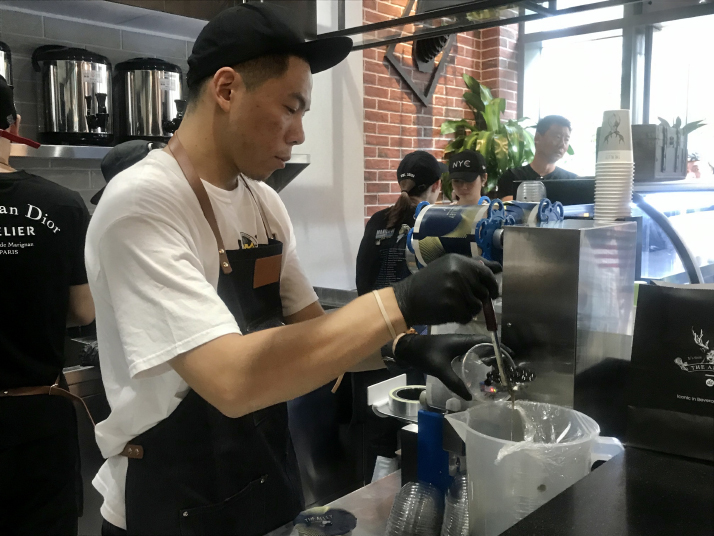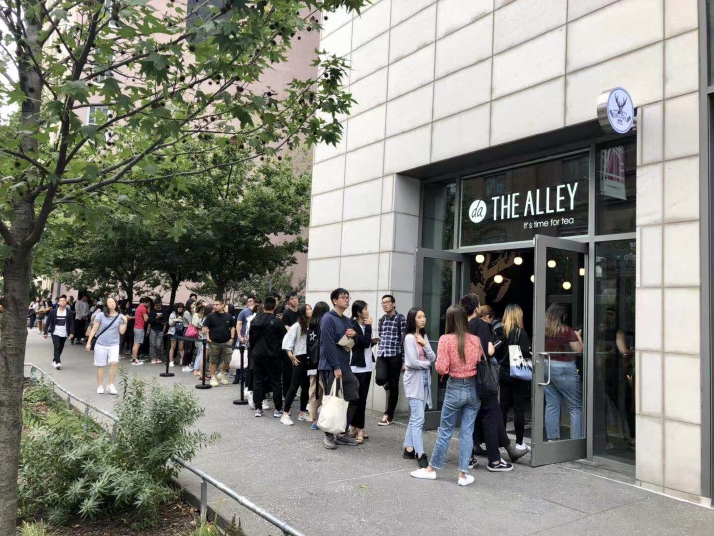| Business |
| Thirst for Bubble Tea | |
| The Asian craze has spread to the rest of the world, including New York City | |
|
|
 A staff member at a bubble tea house in New York City prepares a customer's drink (SHERRY QIN)
On a Tuesday afternoon, Carmen, 13, walked into a ViVi Bubble Tea store in New York City and ordered a half cup of tapioca balls as her two toppings, minus milk tea for 50 cents. She then spent her after school time sucking up the sweet and chewy bubbles through an extra-large straw while watching videos on the free in-store Wi-Fi. "I usually get bubble tea every day, but I ran out of money this month, so I will only order bubbles until I get my allowance," she said. While Chinese millennials went crazy for this sweet and creamy drink earlier, young people across the Pacific Ocean have also started to crave this Asian drink. Bubble tea, which originated in Taiwan, was first seen in New York in the early 2000s. In 2019, a new wave hit the city, with over 20 new tea houses popping up across the city. "New York is estimated to be one of the fastest growing bubble tea markets in North America and the world this year," said Dhritiman Hazarika, food and beverage analyst at Technavio, a market research company. Both local brands that have already made a splash like Kung Fu Tea and ViVi, along with the most sought-after chains from Asia, such as The Alley and Yi Fang Fruit Tea, are slated to grab a share of this rising market with innovative recipes and excellent service. A global boom The worldwide bubble tea market was valued at $2.25 billion in 2018 and projected to grow to $3.21 billion by 2023, according to a research report of Technavio. TA Associates, a private equity firm, announced in September it will invest in Gong Cha, the Republic of Korea bubble and milk tea brand. The firm will acquire 100 percent of the company from Unison Capital and its other backers for about $288 million, according to Korea Economic Daily. Gong Cha also brought on board Peter Rodwell, former division president of McDonald's Corporation, as new executive chairman, seeking to broaden its global influence beyond Asia. In addition, bubble tea brands, catering to people's health pursuits, upgraded the once low-quality street drink to consist of tea products with premium ingredients and strict quality control. While flavor is still a key criterion, U.S. consumers prefer healthier bubble tea drinks with natural ingredients and low sugar. Currently, there are a total of 151 bubble tea stores in New York, according to the New York City Department of Health and Mental Hygiene. Gong Cha, Kung Fu Tea, ViVi and Coco Fresh Tea and Juice, with 102 locations in total, are the leading players in the market.  A long line of people stretch out the door of The Alley on the bubble tea shop's opening day of its first New York City outlet on September 7 (SHERRY QIN)
Customization and innovation ViVi, which was launched in 2007 in the U.S., serves 65 different drinks, from fruit teas, slushes, to flavored teas and milk teas. Consumers then customize their drinks by adding different toppings, including tapioca balls, grass jelly and pudding, and finally choose their ice and sugar levels. Yu An, owner of a ViVi franchise in New York, said her customers always ask for extra tapioca balls no matter what they order. The balls, or bubbles, are made from cassava starch, sweet potato and brown sugar. "I love the gummy-bear texture of bubbles. It also adds another layer of flavor to the tea," said Carmen. The Alley, a newcomer to the New York bubble tea scene, has a cult following for its handcrafted tapioca balls. On opening day of its first store in the U.S., a line of over 100 people stretched outside. "We sold over 1,000 drinks on our opening day," said Josh Liu, owner of the two franchises in New York. "I am here for their signature drink, Sugar Deerioca," said Stella, who drove from New Jersey to be one of the first to get a taste of the drink. The drink is made of handcrafted tapioca balls, caramelized brown sugar and milk. She posted a photo of the brown syrup running through the inside of the cup to her Instagram account before taking a sip. "There is so much we can do with tapioca. I have even seen a brown sugar tapioca ice cream bar," said Liu. The Alley is not the only one experimenting with new recipes. Bubbleology, a chain from London, has added a menu featuring alcoholic drinks with bourbon and white rum, for example. According to Technavio's research, the introduction of products with different flavors will drive bubble tea market growth by 7 percent from 2019 to 2026. While serving walk-in customers, An also checks her iPad every five minutes for online orders. After coffeehouse chain Starbucks partnered up with Uber Eats to provide coffee delivery service in early 2019, bubble tea stores in New York also upgraded their services by joining forces with delivery platforms such as Seamless, Uber Eats and Hungry Panda. In China, food delivery, enabled by both technology and sufficient labor, has embedded itself in urban residents' lives. Yet coffee and tea deliveries have only kicked off recently in U.S. metropolitan areas. "Delivery service helps bubble tea shops expand their influence from 1.5 to 5 miles," said Kayla Kong, a marketing manager at Hungry Panda, an Asian-food delivery app. "Our daily [in-store] sales depend a lot on the weather. Only a dozen customers walk in on a bad weather day, but through delivery platforms, we can make up our sales," said An. "People won't pay a delivery fee for coffee because it is available everywhere, but they will for bubble tea," said Kong.
Spreading via franchises An opened her store in Lower Manhattan's East Village, in August 2019 for approximately $300,000. As a franchise owner, she paid the parent company an initial startup fee to license the brand, received support and guidance on how to make the drinks and now pays the parent company a periodic franchise fee. "This model enables franchisers to expand their geographical presence rapidly without investing in outlets," Hazarika said. The approximate cost for materials for each cup is 75 cents, while a medium cup of bubble tea costs about $4 or more, marking a 400-percent profit, according to Boba Tea Direct, a bubble tea ingredient wholesaler. But Hazarika said that the bubble tea franchise business greatly depends on the location of the outlet and the consumer demographics it serves. Along with Flushing's Chinatown in Queens, a traditional bubble tea hotspot, the East Village, where New York University (NYU) is located, has become the second most popular destination for franchises. "A lot of regular customers are NYU students. They love grabbing a cup of tea before heading to class or to the library," said An. "Although my customers are still predominantly Asians and Asian-Americans, I have seen a growth to a more diverse population." An is excited by the burgeoning bubble tea boom, but also concerned that it will be like its predecessors frozen yogurt and cupcakes, inevitably becoming the next market bubble. "A major challenge for a franchise business is ensuring a return on investment, because the cost of setting up and maintaining a bubble tea business is high," said Hazarika. (Reporting from New York City) Copyedited by Rebeca Toledo Comments to linan@bjreview.com |
|
||||||||||||||||||||||||||||
|